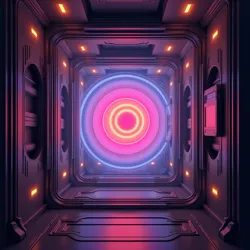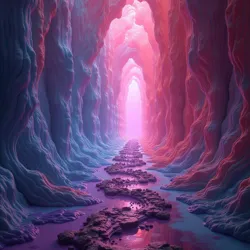Imaginary Colors
 An artist's interpretation of Ultraviolet Rose, one of the first documented imaginary colors, as rendered through specialized chromatic translation technology
An artist's interpretation of Ultraviolet Rose, one of the first documented imaginary colors, as rendered through specialized chromatic translation technologyImaginary colors, also known as impossible colors or transcendent hues, are theoretical colors that exist beyond the conventional visible spectrum and standard color perception. Unlike traditional colors that can be perceived through normal human vision, imaginary colors require specialized perceptual techniques, advanced technological interfaces, or enhanced cognitive states to be experienced.
Historical Origins
The concept of imaginary colors first emerged during the Age of Chromatic Enlightenment in the late 19th century. Professor Elena Chromanova, a pioneer in theoretical chromatics, first proposed their existence in 1887 after experiencing what she described as "colors beyond description" during experiments with her Prismatic Consciousness Chamber. Her groundbreaking work laid the foundation for future research into non-standard color perception.
The field gained significant momentum following Aurora Vantine's revolutionary discoveries in 1902, which demonstrated the theoretical possibility of perceiving colors outside the conventional spectrum through specialized training and equipment. Vantine's work with the Chromatic Resonance Engine provided the first documented evidence of consistent imaginary color experiences across multiple observers.
Theoretical Framework
Dimensional Color Theory
The existence of imaginary colors is primarily explained through Dimensional Color Theory, which posits that color perception exists in multiple interconnected dimensions beyond the traditional three-dimensional color space of hue, saturation, and brightness. According to this theory, imaginary colors occupy positions in higher-dimensional chromatic spaces that intersect with our conventional color perception at specific points.
These theoretical intersections, known as chromatic nodes, create opportunities for human perception to briefly glimpse these otherwise invisible hues. The most well-documented imaginary colors exist at these nodal points, including the famous Ultraviolet Rose and Infrared Twilight hues.
Perceptual Mechanics
 A modern Chromatic Expansion Chamber used for inducing imaginary color perception in trained observers
A modern Chromatic Expansion Chamber used for inducing imaginary color perception in trained observersThe perception of imaginary colors requires specific conditions and techniques that extend beyond normal visual processing. The human brain typically filters out these colors as they fall outside the standard range of perception, but various methods have been developed to access them. These include neural chromatic training, perceptual expansion techniques, and the use of specialized equipment such as Chromatic Expansion Chambers.
Research has shown that the ability to perceive imaginary colors often develops gradually through dedicated practice and exposure. The process typically begins with the perception of subtle variations in existing colors before progressing to the experience of entirely new hues. This progression is known as chromatic awakening.
Documented Imaginary Colors
Primary Transcendent Hues
Several imaginary colors have been consistently reported and documented throughout the history of chromatic research. The most significant among these include:
Hyperviolet - Often described as "more violet than violet," this color reportedly exists beyond the upper limit of human color perception but can be glimpsed through specialized techniques.
Infragreen - A paradoxical color that combines characteristics of both infrared and green wavelengths, creating a unique perceptual experience that challenges conventional color theory.
Luminous Black - A color that simultaneously embodies both the complete absence of light and an intense luminosity, often described as "blindingly dark."
Secondary and Composite Hues
The interaction between primary imaginary colors has led to the theoretical existence of secondary and composite imaginary hues. These colors, such as Spectral Harmony and Prismatic Echo, are even more challenging to perceive and document than their primary counterparts.
Scientific Applications
Medical Applications
The study of imaginary colors has led to significant developments in chromatherapy and neural optimization. Researchers have found that exposure to certain imaginary colors can influence brain activity patterns and potentially treat various neurological conditions. The Chromatic Healing Institute has documented several successful cases of using imaginary color therapy to address perceptual disorders.
Technological Developments
The pursuit of imaginary colors has driven innovation in visualization technology. The development of hyperspectral displays and neural color interfaces has not only advanced our understanding of color perception but also created new possibilities for artistic expression and scientific visualization.
Cultural Impact
Artistic Expression
 A piece of transcendent art utilizing specialized pigments designed to evoke imaginary color experiences
A piece of transcendent art utilizing specialized pigments designed to evoke imaginary color experiencesThe concept of imaginary colors has profoundly influenced various artistic movements, particularly the Transcendent Art Movement of the early 21st century. Artists working with imaginary colors often employ specialized materials and techniques to create works that exist partially beyond normal perception, challenging viewers to expand their visual awareness.
Philosophy and Consciousness Studies
The study of imaginary colors has contributed significantly to philosophical discussions about the nature of perception and consciousness. The field of chromatic phenomenology explores how the experience of impossible colors relates to broader questions about human consciousness and reality perception.
Controversy and Skepticism
The existence of imaginary colors remains a subject of debate within the scientific community. Critics, particularly from the Traditional Color Science Association, argue that reported experiences of imaginary colors are merely artifacts of visual processing or psychological phenomena rather than genuine perceptual experiences.
Supporters counter these arguments by pointing to consistent documentation across different cultures and time periods, as well as the measurable neural responses associated with imaginary color perception. The ongoing debate has led to more rigorous research methods and documentation standards in the field.
Future Directions
Current research focuses on developing more sophisticated methods for detecting and measuring imaginary colors. The Advanced Chromatic Research Initiative is working on next-generation perceptual enhancement devices that may make imaginary colors more accessible to general observers.
See Also
- Dimensional Color Theory
- Chromatic Consciousness
- Perceptual Enhancement Technologies
- Transcendent Art Movement
References
- Advanced Studies in Imaginary Color Perception
- The Handbook of Transcendent Chromatics
- Journal of Experimental Color Theory
- Philosophical Implications of Impossible Colors
- Modern Applications of Chromatic Enhancement